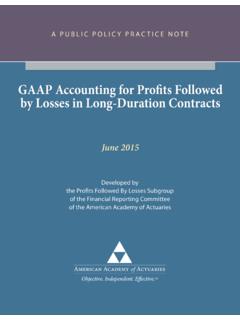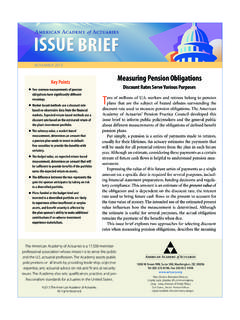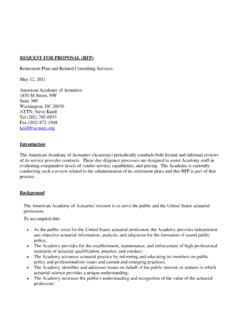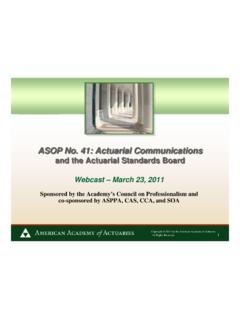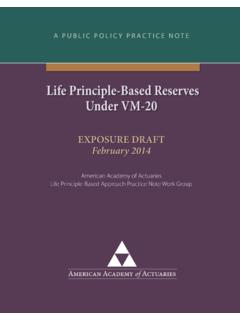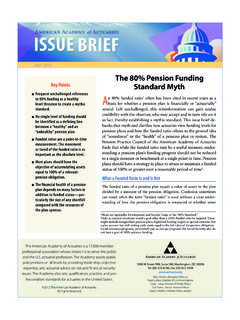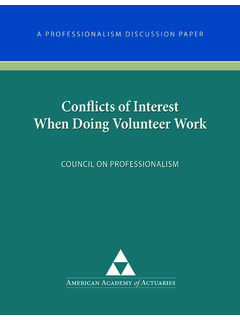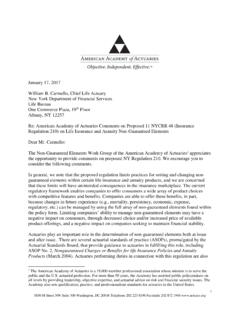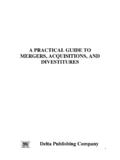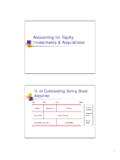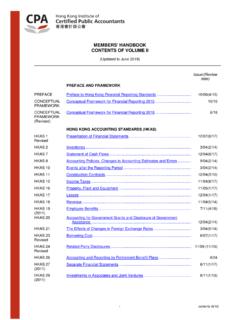Transcription of Treatment of VOBA, Goodwill and Other Intangible Assets ...
1 Treatment of voba , Goodwill and Other Intangible Assets under PGAAPA Public Policy PrActice NoteFebruary 2014 American Academy of ActuariesLife Financial Reporting CommitteeEXPOSURE DRAFTA PUBLIC POLICY PRACTICE NOTE Treatment of voba , Goodwill and Other Intangible Assets under PGAAP April 1, 2014 Developed by the Life Financial Reporting Committee of the American Academy of Actuaries The American Academy of Actuaries is an 18,000-member professional association whose mission is to serve the public and the actuarial profession. The Academy assists public policymakers on all levels by providing leadership, objective expertise, and actuarial advice on risk and financial security issues. The Academy also sets qualification, practice, and professionalism standards for actuaries in the United States. Treatment OF voba , Goodwill AND Other Intangible Assets UNDER PGAAP American Academy of Actuaries.
2 All rights reserved. This practice note is not a promulgation of the Actuarial Standards Board, is not an actuarial standard of practice, is not binding upon any actuary and is not a definitive statement as to what constitutes generally accepted practice in the area under discussion. Events occurring subsequent to this publication of the practice note may make the practices described in this practice note irrelevant or obsolete. The authors of this practice note are not accountants or tax experts. The reader should consult professionals with expertise in these areas. This practice note was prepared by the Life Financial Reporting Committee of the American Academy of Actuaries. Please address all communications to Steve Malerich, FSA, MAAA, Chair Elizabeth Rogalin, FSA, MAAA, Vice-Chair Rod Bubke, FSA, MAAA Larry Gulleen, FSA, MAAA Noel Harewood, FSA, MAAA Ken LaSorella, FSA, MAAA Mike Leung, FSA, MAAA Joseph Rafson, FSA, MAAA Lenny Reback, FSA, MAAA Duncan Szeto, FSA, MAAA Connie Tang, CERA, FSA, MAAA Randy Tillis, CERA, FSA, MAAA Aaron Weatherman, CERA, EA, FSA, MAAA With special thanks to Barbara Gold and Ed Robbins of the Academy s Life Tax Work Group 1850 M Street , Suite 300 Washington, 20036-5805 Treatment OF voba , Goodwill AND Other Intangible Assets UNDER PGAAP American Academy of Actuaries 1 TABLE OF CONTENTS Contents Part A.
3 Background .. 2 Part B. Calculation of Value of Business Acquired: Initial Measurement .. 5 Method 1: voba via Actuarial Appraisal Method .. 6 Method 2: voba as PGAAP Liability less FVL .. 9 Part C. Tax Considerations in the Calculation of Initial 14 Part D. Other Items on the PGAAP Balance Sheet .. 24 Part E. Subsequent Measurement .. 27 Appendix I: Distributable Earnings and VIF .. 32 Appendix II: Additional Tax Issues .. 36 Appendix III: Summary of Formulas .. 43 Appendix IV: Glossary of Abbreviations and Acronyms .. 45 Treatment OF voba , Goodwill AND Other Intangible Assets UNDER PGAAP American Academy of Actuaries 2 Part A. Background Purchase accounting PGAAP In 1970, accounting Principles Board Opinion No. 16 (APB 16), Business Combinations, was issued along with its companion guidance, APB 17, Intangible Assets . APB 16 allowed both the pooling-of-interests and the more prevalent purchase method of accounting .
4 The purchase method of accounting under Generally Accepted accounting Principles (GAAP) is commonly referred to as Purchase GAAP, or simply PGAAP, the subject of this practice note. Following APB 16, there were numerous interpretations by the American Institute of Certified Public Accountants (AICPA) and the Financial accounting Standards Board (FASB), as well as issues addressed by the Emerging Issues Task Force (EITF), but little guidance for actuaries. In 2001, Statement of Financial accounting Standards 141 (SFAS 141), Business Combinations, and SFAS 142, Intangible Assets , superseded APB 16 and APB 17, respectively, and eliminated the pooling-of-interests method, requiring that all business combinations be accounted for under the purchase method. SFAS 141 incorporated most of pre-existing guidance related to the purchase method. Finally, SFAS 141R, superseded SFAS 141 in 2007 and requires all business combinations to be accounted for under the acquisition method (essentially a different name for the purchase method of SFAS 141).
5 The valuation of PGAAP liabilities is beyond the scope of this practice note, which focuses on the PGAAP Treatment of value of business acquired ( voba ), Goodwill , and Other Intangible Assets . This practice note will refer, where possible, to the FASB accounting Standard Codification (ASC) as the source of authoritative GAAP guidance. Detailed methodology for calculation of the value of after tax statutory income of a portfolio of insurance (Valuation of Insurance In Force, or VIF) is also beyond the scope of this Practice Note, Other than to define in general what it represents and how it might be used in PGAAP. SFAS 141R was codified into current GAAP guidance under ASC Topic 805. References to tax and statutory in this practice note assume that the reporting entity is a taxpayer valuing business in a life insurance company. Further, the practice note makes no attempt to anticipate changes in the relevant tax or statutory accounting standards.
6 Part A: Q1. When is PGAAP applied? A. PGAAP is applied when a business combination occurs. In the insurance industry, business combinations may occur through merger and acquisition activity, including some reinsurance structures. ASC 805-10-15-4 (Paragraph 2 of SFAS 141R) excludes joint ventures or the merger of companies already under common control ( , the merger of two wholly owned subsidiary companies) from the definition of business combinations. Similarly, the same paragraph excludes the acquisition of Assets that do not constitute a business from the definition of business combinations. Part A: Q2. How is a business defined for purposes of PGAAP? A. According to ASC 805-10-20, a business is defined as An integrated set of activities and Assets that is capable of being conducted and managed for the purpose of providing a return .. to investors or Other owners, members, or participants.
7 A business consists of all of the following: a. Inputs, b. Processes applied to those inputs, and Treatment OF voba , Goodwill AND Other Intangible Assets UNDER PGAAP American Academy of Actuaries 3 c. Ability to produce outputs that have the ability to generate returns. In short, an integrated set of Assets and activities acquired must be capable of being conducted and managed as a business by a market participant. (ASC 805-10-55-8) As a result, coinsurance of a closed block where no staff or administration systems are transferred is unlikely to constitute a business combination , whereas a coinsurance deal that does transfer staff and distribution capability would typically constitute a business combination . The determination of whether an acquired group of Assets constitutes a business is typically handled by accounting professionals, rather than actuaries. Part A: Q3.
8 What is required to apply PGAAP to a business combination ? A. According to ASC 805-10-05-4, in applying PGAAP: The acquisition method requires all of the following steps: a. Identifying the acquirer, b. Determining the acquisition date, c. Recognizing and measuring identifiable Assets acquired, the liabilities assumed, and any non-controlling interests, and d. Recognizing and measuring Goodwill or a gain from a bargain purchase. Part A: Q4. What is the objective of PGAAP with respect to measurement of Assets and liabilities at the acquisition date? A. Assuming a transaction has been determined to be a business combination , which requires that Assets acquired and liabilities assumed constitute a business, a principal objective of PGAAP as described in ASC 805-20-30-1 (paragraph 20 of SFAS 141R) is to measure the identifiable Assets acquired, the liabilities assumed, and any noncontrolling interest in the acquiree at their acquisition-date fair values.
9 Part A: Q5. Does a PGAAP balance sheet require each asset and liability to be presented at fair value? A. While the objective is to produce a fair value balance sheet, ASC 805 recognizes that many ongoing Assets and liabilities related to insurance and reinsurance would not be measured at fair value at valuation dates subsequent to the date of acquisition. For insurance and reinsurance contracts acquired in a business combination , ASC 944-805-30-1 (SFAS 141R paragraph E16) specifies that an acquirer shall recognize that fair value in components. The first component (the asset or liability for insurance or reinsurance contract) is measured in accordance with the acquirer s accounting policies; the second component is an Intangible asset (or occasionally a liability) representing the difference between (1) the fair value of insurance and reinsurance Assets acquired and liabilities assumed and (2) the first component.
10 For example, assume that the liability established for a universal life contract pursuant to an acquirer s accounting policy is a policyholder account value (AV) of $1,000. Assume the fair value liability (FVL) is $900, an exit price defined by ASC 944-40-20 (the amount that would be paid to a market participant to transfer the liability). The PGAAP balance sheet would show a liability of $1,000 and an Intangible asset of $100 (the difference between the PGAAP liability and the FVL). Treatment OF voba , Goodwill AND Other Intangible Assets UNDER PGAAP American Academy of Actuaries 4 There is no official term in the accounting literature for this Intangible asset . In practice this Intangible asset is generally referred to as Value of Business Acquired or While the PGAAP liability is clearly not an FVL, the net GAAP liability the PGAAP liability less voba is the fair value.
